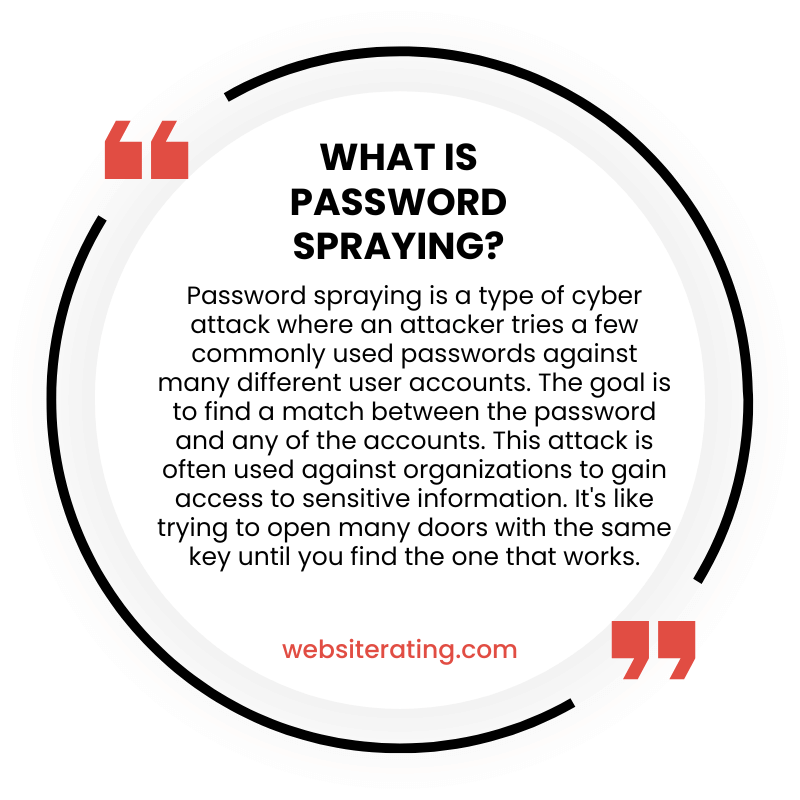Password spraying is a technique used by malicious actors to gain access to accounts. It involves making multiple login attempts using commonly-used passwords across different user accounts. This technique can be used in combination with other cyberattacks, such as brute force and dictionary attacks, to significantly increase the chances of success.

By understanding the mechanics behind password spraying, organizations can take steps to protect their systems from unauthorized access. In this article, we will provide an overview of password spraying and discuss practical examples for beginners.
How Does Password Spraying Work?
Through a process of systematically attempting multiple credentials, password spraying is a technique used to identify accounts with weak or commonly-used passwords. This method of attack relies on guessing passwords by using large lists of common words and phrases until an account is successfully logged into. Password spraying often targets large volumes of users in order to find the few that are vulnerable to this type of attack.
While this method does not target specific users, it can be dangerous if successful as attackers can gain access to user accounts without alerting security teams. To protect against this type of attack, organizations should implement strong authentication methods such as multi-factor authentication and password complexity rules.
Additionally, users should be encouraged to use unique passwords across all their accounts and take advantage of password manager tools like LastPass or 1Password that can help generate secure passwords for each account they have.
What Can You Do to Protect Yourself?
Taking proactive measures can help protect an individual from the risks associated with password spraying. One of the most important steps to take is to use strong, unique passwords for each account or website that requires one. This means that when creating a new password, it should be at least 12 characters in length and contain a combination of letters, numbers, and symbols. Additionally, it should be different from any other passwords used on other accounts or websites. Reusing the same password across multiple sites increases the risk of becoming a victim of password spraying.
Another important measure to take is to enable two-factor authentication (2FA) whenever possible. 2FA requires users to provide two forms of authentication before logging into an account or website; this can include providing both a username/password as well as an additional form such as a code sent via text message or email address. Enabling 2FA helps to add an extra layer of security which can make it much more difficult for hackers to access your accounts using password spraying techniques.
Practical Examples for Beginners
For those new to the concept of password spraying, practical examples are provided to help illustrate how to protect oneself from this type of cyberattack.
One of the most common methods for beginners is to use a secure and unique password for each account they create. This means that if one account is compromised, all other accounts remain unaffected. Additionally, it is important to not reuse passwords across different sites as attackers may be able to access multiple accounts with the same credentials.
Furthermore, it is recommended that users make use of two-factor authentication whenever possible and employ password managers such as LastPass or 1Password in order to easily generate strong passwords and store them securely.
Finally, users should also be aware of phishing attempts which could lead them into revealing their passwords or other sensitive information. By following these simple steps, users can significantly reduce their risk of falling victim to a password spraying attack.
Summary
Password spraying is an effective yet dangerous tactic used by malicious actors in attempts to gain access to sensitive information. It involves attempting a large number of commonly used passwords against many different accounts, making it difficult for organizations to detect.
To protect themselves from password spraying, organizations should implement strong authentication measures and regularly monitor their systems for suspicious activity. Additionally, users should have unique passwords for each account and must take steps to ensure the security of those credentials, such as using a secure password manager that stores them in an encrypted form.
By understanding the risks posed by password spraying and taking appropriate actions, individuals and businesses alike can better protect their data from unauthorized access.
More reading
Password spraying is a type of brute-force cyberattack where a cybercriminal tries to guess a known user’s password using a list of common, easy-to-guess passwords such as “123456” or “password.” (source: Auth0). In this attack, an attacker will brute force logins based on a list of usernames with default passwords on the application (source: OWASP Foundation). As the name implies, the attacker is just spraying, hoping that one of these username and password combinations will work. The successful password spraying attack leaves the victim more vulnerable to a variety of future attacks (source: CrowdStrike).
